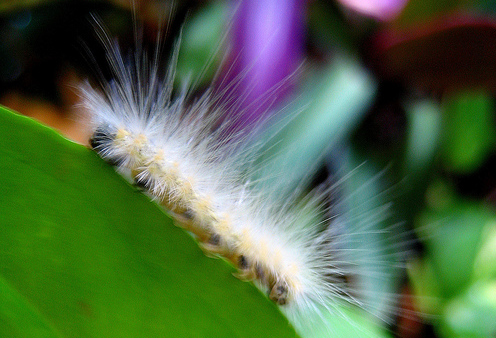Controlling fall web worms…before they damage your trees, shrubs and some vines.

Coming back from NW Arkansas after a college football game, I became aware of the immense fall web worm infestation along the highway. You need to get the information on how to identify and control these web-forming insects.
Identifying what type of caterpillar you have is a little easier by where the web is located. The fall web worm builds at the tip of the branch while the tent caterpillar makes its home in the fork of the branches. Just as the tent caterpillars are completing their nest, the fall web worm tent-like structures begin to appear. It seems like this happens overnight because the fall web worm does most of its work during the evening hours.
The fall web worm caterpillar is about 1″ long, is very hairy and pale green or yellow, with either a red or black head. They overwinter as pupae in cocoons that are hidden in either the bark of the tree or in the soil. The moths emerge from mid-March to mid-late April. They are satin white with brown wing spots.
The first generation of caterpillars start to feed sometime in mid-spring to early summer. After feeding, they pupate in the soil and a second generation of web worms will be seen during August or September. The second generation is more destructive with defoliation of the plant than the first generation.
Controlling these pests is important. You can destroy the tents, especially when they are small. Best time is around dusk or early morning when the larvae are in the tent. On smaller trees, they may be pruned and destroyed. But on larger trees and trees with several nests, you need to spray.
Bacillus thuringiensis (Bt) and bifenthrin (Bug Blaster) are effective against the fall web worms. Bacillus thuringiensis (Bt) is a microbial pesticide that can be applied as a dust or spray. It kills many types of caterpillars but has no effect on warm-blooded animals or bees. Always use Bt with care, because it also can kill the larvae of non-pest moths and butterflies.
Bifenthrin is a pyrethroid which has a long lasting residual. Rule of thumb…application should be made when the larvae are small and easiest to control, not when they are full grown and have already done their damage.
Inspection for the greenish egg masses of the fall web worms can be accomplished by looking on the underside of leaves anywhere from spring to late fall. A little extra work inspecting the trees will go a long way in reducing the infestations later in the fall.

Leave a Reply